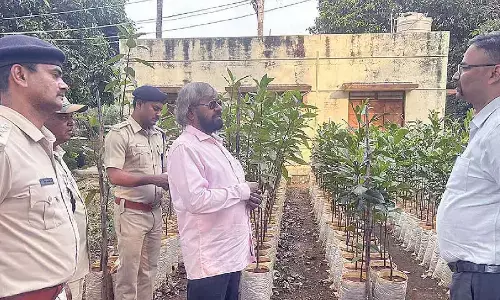Digital payment innovation in India

Digital payment innovation in India
Digital payment revolution is inspiring the world.
Digital payment revolution is inspiring the world. The Union government feels that India's digital payment innovation is a game-changer for the economy. India has built a homegrown instant payment system that has remade commerce and pulled millions into the formal economy.
The foundation of the 'digital public infrastructure' was laid by the government and built upon by a robust public-private partnership. It has made daily life more convenient, expanded banking services like credit and savings to millions more Indians, and extended the reach of government programmes and tax collection, though a lot more to promote the digital payments needs to be done. For example, due to lack of awareness, people in major cities like Visakhapatnam are still preferring manual payment mode for municipal services.
Prime Minister Narendra Modi described the digital payment ecosystem to the G20 Finance Ministers as a free public good that has radically transformed governance, financial inclusion and ease of living in India. The digital infrastructure is seen as a set of 'rail tracks' laid by the government, on top of which innovation can happen at a low cost.
With this network, India has shown on a previously unseen scale how rapid technological innovation can have a leapfrog effect for developing nations, spurring economic growth even as physical infrastructure lags. It is a public- private model that India wants to export as it fashions itself as an incubator of ideas that can lift the world's poorer nations.
At the heart of this initiative is the famed JAM trinity – Jan Dhan accounts, Aadhaar and Mobile, the three pillars that revolutionised the entire economic ecosystem of India.
The second pillar of Aadhaar transformed identity services. Aadhaar ID can be used for digital authentication through two-factor authentication or biometric IDs. Aadhaar-led authentication has become an enabler for institutions like banks and telcos.
Today, 99 per cent of adults have a biometric identification number with more than 1.3 billion IDs issued. The IDs eased the creation of bank accounts and became the foundation of the instant payment system.
The third pillar is that of Mobile, which showcases the core digital innovation in India's telecom sector. After the disruptive entrance of Reliance Jio in 2016, the cost of data dropped by 95%. It led to every Indian having low-priced and easy access to the internet. This catapulted verticals such as e-commerce, food delivery, and OTT content to take off in India. Most importantly, it made the digital payment system accessible to the last and the least in the remotest regions of India.
With telcos enabling internet access and smartphone penetration increasing, along with the spread of financial inclusion through Jan Dhan enabled by Aadhaar authentication, the Indian payments ecosystem underwent a paradigm shift. This resulted in the conceptualisation of the Unified Payments Interface (UPI) which has supercharged India's transition to non-cash payments by facilitating direct payments linked to a bank account.
UPI is a public-private partnership (PPP) that the National Payments Corporation of India (NPCI) led with an interoperable platform. The platform offers services from hundreds of banks and dozens of mobile payment apps, with no transaction fees.
FinTech, banks, and telcos have adopted this platform and have further driven UPI growth through QR code placements at merchant point-of-sale (POS).
In January, about eight billion transactions worth nearly $200 billion were carried out on the UPI, according to Dilip Asbe, the managing director of the NPCL, which oversees the platform. Today, 40% of all payments are digital.
The value of instant digital transactions in India last year was far more than in the United States, Britain, Germany, and France. "Combine the four and multiply by four — it is more than that," as one Indian cabinet minister, Ashwini Vaishnav, told the World Economic Forum in January.
The system has grown rapidly and is now used by close to 300 million individuals and 50 million merchants. Digital payments are being made for even the smallest of transactions, with nearly 50 per cent classified as small or micropayments: Rs 10 for a cup of milk chai or Rs 200 for a bag of fresh vegetables. That is a significant behavioural shift in what has long been a cash-driven economy.
The demonetisation drive to eradicate black money and the social distancing norms during the pandemic also created a push toward the digital payment infrastructure.
On the robustness of the digital payment system, Amitabh Kant, G20 sherpa, said that the government has struck the right balance between privacy and innovation. "We said that the data belongs to the individual and that he has the right to give consent for every transaction that he undertakes," he said.
Even in sectors that have not yet adopted digital payments, like the fishing industry in the southern state of Kerala, the basic pillars of the digital infrastructure — the identity number, bank accounts, and mobile phone apps—made it easier to deliver services.
The success of the digital payment system, however, lies not just in the robustness of the digital payment infrastructure but also in the behavioural nudge that encouraged people to switch from cash to digital. Like any behavioural change, it had to be based on trust and accessibility of the system through insightful innovations that ensure its relevance to its core group.
These include small and interesting innovations like small voice boxes provided by payment apps are a fixture at snack carts and tea stalls, where vendors are too busy to check phone messages after every small transaction.
Finance product innovations like loans for phones have brought premium phones within the reach of the masses even in small towns. This has been possible due to the breadth of financial inclusion piggybacked on Aadhaar authentication and mobile internet use.
India's digital payment ecosystem is a classic example of Ecosystem thinking where underlying core assets and capabilities were strengthened which had a positive spillover effect. This, in turn, revolutionised business, entrepreneurship as well as consumption patterns in India, making India's Digital Payment Ecosystem a game-changer and a global inspiration.

















